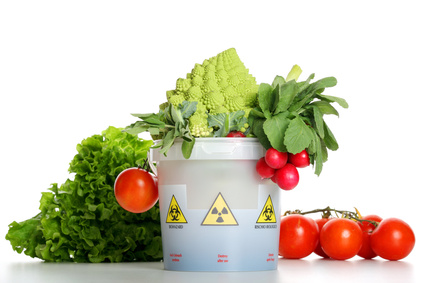Checking foods with the Geiger Counter

With our handy radiation gauge or geiger counter (approx. 6 oz) –which easily fits in any handbag– you can check your groceries for radioactivity either when shopping or later at home. You can therefore always be assured that you and your family will enjoy uncontaminated foods.
Since the range of alpha particles within the air extends only to a few inches, however, detecting mildly alpha-radiating foods is difficult in practice.
Radioactive Contamination of Foods
The Pasture–Cow–Milk Pathway
One of the most observed food chains in the wake of the nuclear reactor accident of Chernobyl was the pasture-cow-milk pathway. The radioactive contamination of milk played an important role especially in the nutrition of small children. In cows, which had been fed with contaminated fresh fodder, the iodine-131 content increased initially to more than 1,500 becquerel per liter (Bq/l) and the caesium-137 content increased up to 400 Bq/l of milk. Based on a rapid decrease of the iodine content as well as on the growth of fresh grass mass within a short time, already by June of 1986 the grazing livestock had lesser contaminated feed available. However, due to the highly contaminated winter feed –consisting of hey that cut in May of 1986– the caesium content in milk and in beef increased again. The content of radioactively contaminated cereals in the winterfeed impacted especially the activity-history of pork.
Enrichment of Radioactive Isotopes
The content and the biological availability of caesium decrease only very slowly in forests. When the Chernobyl cloud passed through, the canopy of trees functioned as a giant filter for radioisotopes in the air which eventually reached the upper ground layer through the fall of leaves or needles. This layer is nutrient-deficient and acidic, conferring a high mobility to harmful substances such as caesium. Caesium can thus be quickly absorbed by plants, which in turn slows down its transfer into the deeper layers of the ground.
The humus layer and the adjoining humus mineral soil in the forest are an important storage for radioactive caesium. Since soil in the forest is not mechanically cultivated and not regularly fertilized and harvested, the entire imprint of the radioactive contamination in the forest is maintained nearly continuously. This explains why produce of the forest (berries, mushrooms, game, herbs) are still radioactively contaminated.
Mushrooms, which –like other plants of the forest– are supplied by nutrients of the upper humus layer, are caesium collectors. However, the absorption and the enrichment of radioactive caesium is not the same in all types of mushrooms. Bay boletus and hedgehog mushrooms display the highest absorption capacities.
Caesium Limits for Consumption
Currently, a limit for the overall caesium contamination of 600 becquerel per kilogram (Bq/kg) for foods and of 370 Bq/kg for milk, dairy products, and baby-food applies in the countries of the European Union. The EU-limits apply to foods which are imported from third countries, but they are also applied to domestic products. The monitoring capacity for domestic products, however, is limited. And even the border-controls of food imports into the EU are not always reliable. The Environmental Institute in Munich has discovered highly contaminated chanterelles in 1997 on the weekly markets in Munich which had probably originated in the Ukraine and which had been imported via Austria.
Independent experts have called for stricter limits based on the Radiation Protection Ordinance (1976). Foods for adults should contain no more than 30 to 50 Bq/kg, and foods for children, nursing and pregnant women no more than 10 to 20 Bq/kg. These values are based on 1% of strontium-90 with regard to the activity-content of caesium-137. Because of uncertainties in the evaluation, a maximum limit of 5 Bq/kg of caesium overall-activity is recommended for children’s foods.
Since not limit can be indicated under which radioactivity would be harmless, the minimum-principle suggests that as little radioactivity as possible should be absorbed.
